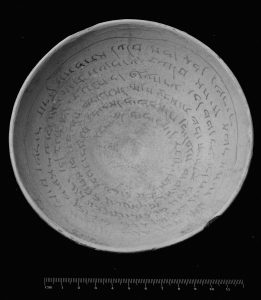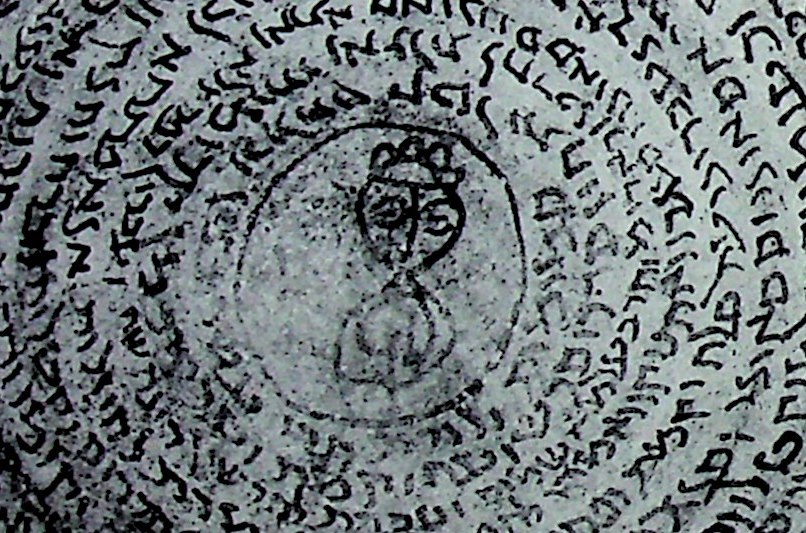| Source (Aramaic & Hebrew) | Translation (English) |
|---|---|
גבריאל מימינהון דדודיתא בת דודי ובנה ובנתה ומיכאל מישמאלה ומילפנה סוסיאל ומילאחרה מנוחא ומילמעלה שכינתאל יהוה צבאות שמו (ישעיה נא:טו) |
May Gavriel be on the right of Dudita bat Dudai, and her sons and her daughters,[1] The name of the woman for whom this amulet bowl is being put to use, and her progeny. and Mikhael be on her left, and before her, Susiel, and behind her, Menuḥa, and above her, Shekhinat-El. “YHVH Tsevaot is his Name” (Isaiah 51:15). |
הרחיק מינה מן דודיתא בת דודי ומן בנה ומן בנתה כל הפגע רע וכל שטן רע וכל חיה רע וכל דבר רע וכל מוצא רע וכל הרוחות תשמיש בעולם אהיה אשר אהיה (שמות ג:יד) אמן אמן סלה הללויה וקים ושריר |
Remove from her, from Dudita bat Dudai, and from her sons and from her daughters, [2] See note above. every evil affliction and every evil satan[3] lit. accuser. and every evil ḥayah[4] lit. living creature, i.e., a dangerous wild animal in contradistinction to a behemah, a tame or domesticated animal. and every evil decree[5] lit. word. and every evil utterance and all the Succubi[6] lit. spirits of intercourse. in the world. Ehyeh Asher Ehyeh[7] the divine name, which literally translates to “I am that I am.” (Exodus 3:14). Amen, Amen, Selah. Hallelu-Yah! and [it is] binding and valid. |
הדין חתמתא לעלם אמן ואמן ושריר |
This seal is forever. Amen and Amen. And [it is] valid. |
The text and translation of an amulet bowl discussed in “‘Gabriel is on their Right’: Angelic Protection in Jewish Magic and Babylonian Lore” by Dan Levene, Dalia Marx, and Siam Bharyo in Studia Mesopotamica (Band 1: 2014) pp.185-198. “Typically, such bowls come from Mesopotamia and date to the late Sasanian period.” In archaeological excavations, the bowls have been found below the threshold of Jewish homes, faced downward, the theory being that unwanted spirits attempting to enter the home from below this entrance would be drawn instead into the concave area of the bowl and thus be blocked in their passage.
The apotropaic incantation found in the amulet bowl, SD 12, contains an “angels on all sides” formula similar to that appearing in the Jewish liturgy of the bedtime shema. As the authors explain, such formulas have been found in cuneiform tablets as far back as the second millennium B.C.E. in the context of a healing ritual by an āšipu, a “physician-exorcist.”
For variations on this formula appearing in rabbinic Jewish liturgy, find the differences in a traveler’s prayer (from Seder Rav Amram Gaon, 9th c.), in an early formulation of the kriyat shema al hamitah (in Maḥzor Vitry, 11th c.), and in the bedtime shema of a more recent sidddur.
The translation appearing here differs slightly from that of the authors of this article.
Source(s)

Notes
| 1 | The name of the woman for whom this amulet bowl is being put to use, and her progeny. |
|---|---|
| 2 | See note above. |
| 3 | lit. accuser. |
| 4 | lit. living creature, i.e., a dangerous wild animal in contradistinction to a behemah, a tame or domesticated animal. |
| 5 | lit. word. |
| 6 | lit. spirits of intercourse. |
| 7 | the divine name, which literally translates to “I am that I am.” |

“גבריאל מימינהון | “Gavriel is on the right,” an apotropaic invocation of angelic protection in the amulet bowl SD12 (ca. mid-first millennium C.E.)” is shared through the Open Siddur Project with a Creative Commons Attribution-ShareAlike 4.0 International copyleft license.




![[Ḳameʻ] : [ʻavur Mirḳada d.m Ṿiadah bat Donah] (Columbia University Hebrew Manuscripts Collection, MS General 194) - cropped](https://opensiddur.org/wp-content/uploads/2020/08/ldpd_11683790_000_00000001-featured-image.jpg)





Leave a Reply